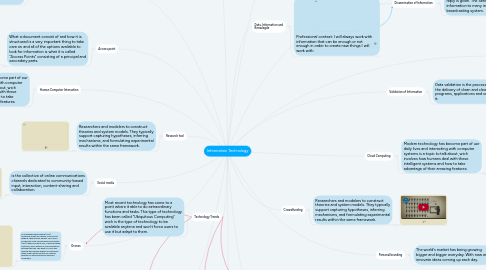Information Technology
by Javier Saldaña


1. Virtual Reality
1.1. Is an interactive computer-generated experience taking place within a simulated environment. It incorporates mainly auditory and visual feedback, but may also allow other types of sensory feedback like haptic. This immersive environment can be similar to the real world or it can be fantastical.
1.1.1. Example
1.1.1.1. .
2. Organization of Information
2.1. Formal
2.1.1. It has an structure and objetive. Theres usually a leader and everybody has a useful asigned task.
2.2. Informal
2.2.1. It lacks an structure and everybody participates to get to the objetive, this increaces the creativity and co-work relationship.
3. Technology Trends
3.1. Most recent technology has come to a point where it able to do extraordinary functions and tasks. This type of technology has been called "Ubiquitous Computing" wich is the type of technology to be avaliable anytime and won't force users to use it but adapt to them.
4. Research tool
4.1. Researchers and modelers to construct theories and system models. They typically support capturing hypotheses, inferring mechanisms, and formulating experimental results within the same framework.
4.1.1. .
5. Social media
5.1. is the collective of online communications channels dedicated to community-based input, interaction, content-sharing and collaboration.
5.1.1. .
6. Human Computer Interaction
6.1. Modern technology has become part of our daily lives and interacting with computer systems is a topic to talk about, wich involves how humans deal with these intelligent systems and how to take advantage of their amazing features.
6.1.1. .
7. Drones
7.1. An unmanned aerial vehicle (UAV), commonly known as a drone, is an aircraft without a human pilot aboard. UAVs are a component of an unmanned aircraft system (UAS); which include a UAV, a ground-based controller, and a system of communications between the two. The flight of UAVs may operate with various degrees of autonomy: either under remote control by a human operator or autonomously by onboard computers.
7.1.1. .
8. Access point
8.1. What a document consist of and how it is structured is a very important thing to take care on and all of the options avaliable to look for information is what it is called "Access Points" consisting of a principal and secondary parts.
8.1.1. .
9. Knowledge society
9.1. A society wich generates, shares and makes avaliable to all memebers of the society knowlegde that maybe used to improve to human condition.
10. Data, Information and Knowlegde
10.1. Professional context: I will always work with information that can be enough or not enough in order to create new things I will work with.
11. APA
11.1. The so-called APA style is the standard developed by the American Psychological Association, which authors use when presenting their documents or texts for journals published by the public entity.
12. Personal branding
12.1. The world's market has being growing bigger and bigger everyday. With new and innovate ideas coming up each day.
12.1.1. Eample
12.1.1.1. .
13. Augment Reality
13.1. There is an existent gap between the real and the virtual world. The virtual world has show how amazing it would be to be inside a vitual ambient.
13.1.1. Example
13.1.1.1. .
14. Cloud Computing
14.1. Modern technology has become part of uor daily lives and interacting with computer systems is a topic to talk about, wich involves how humans deal with these intelligent systems and how to take advantage of their amazing features.
14.1.1. .
15. Dissemination of Information
15.1. Information is sent out and received, but no reply is given. The Sender sends out information to many individuals in a broadcasting system.
15.1.1. .
16. Validation of Information
16.1. Data validation is the process that ensures the delivery of clean and clear data to the programs, applications and services using it.
16.1.1. Examples
16.1.1.1. Code
16.1.1.2. Data type
16.1.1.3. Data range
16.1.1.4. Structure
17. Dissemination tools
17.1. To disseminate means to broadcast information publicly without receiving feedback from the audience.
17.1.1. .
18. Weareble computing
18.1. also known as wearables or body-borne computers,[1][2] are small computing devices (nowadays usually electronic) that are worn under, with, or on top of clothing.
18.1.1. Example
18.1.1.1. .
19. Crowdfunding
19.1. Researchers and modelers to construct theories and system models. They typically support capturing hypotheses, inferring mechanisms, and formulating experimental results within the same framework.
19.1.1. .
